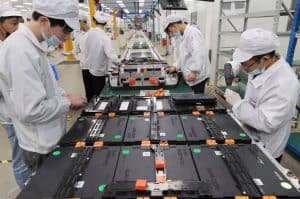
Graphite, a critical mineral used in electric vehicle batteries, could see a shortage in supply amid surging demand for EVs, which may delay the global drive to go green.
Graphite is used for the negative end of a lithium-ion battery, known as the anode. Lithium-ion batteries are commonly used by global carmakers to power their EVs.
With electric vehicle sales expected to reach up to 11 million units in 2022, there could be a deficit of around 40,000 tonnes of graphite this year, said George Miller, an analyst from London-based battery materials data and intelligence provider Benchmark Mineral Intelligence in an interview.
“There is a potential for a raw material deficit in graphite … which would hamper utilisation rates at [battery] cell and electric vehicle production facilities,” said Miller.
While the deficit would not destroy the demand for electric vehicles, it could “push out the timeline for wider integration of electric vehicles in society,” said Miller.
Governments have been encouraging carmakers to produce electric vehicles with subsidies and policy shifts, while there has also been increasing consumer acceptance of EVs, he said.
Growth in graphite demand is forecast to average an 18 per cent increase year on year until 2030, according to Benchmark Mineral Intelligence.
“The demand outlook is incredibly strong for graphite. It will remain a critical mineral for the lithium-ion growth story and the energy transition,” said Miller.
There is about 50 to 100kg of natural flake graphite in every electric vehicle that uses natural graphite anode materials, said
Miller.
Total graphite demand is expected to double by 2035, underpinned by strong battery growth, according to energy and commodities consultancy Wood Mackenzie.
While graphite deposits are not scarce and total supply figures typically meet demand, the supply of battery-grade graphite – used as a raw material for batteries in electric vehicle production – is much tighter, according to Suzanne Shaw, principal analyst at Wood Mackenzie in an emailed comment.
In terms of raw materials, China accounted for 76 per cent of the world’s natural graphite supply and 56 per cent of synthetic graphite supply, according to Wood Mackenzie.
“Chinese production is typically much less expensive than that in other regions because of lower costs for labour, energy and reagents,” said Shaw.
In 2021, China was the world’s leading producer of natural graphite, producing an estimated 820,000 tonnes, or around 79 per cent of total world output, according to a report by the US Geological Survey in January.
Driven by increasing downstream sector demand including lithium-ion batteries, China was expected to produce about 913,000 tonnes of natural graphite in 2025, according to a Frost & Sullivan report in China Graphite Group’s IPO prospectus in late February.
“There is tightness in the graphite anode market which will likely last till the end of this year,” said Daiwa Capital Markets analysts Dennis Ip and Leo Ho in an emailed response to questions from the Post.
Graphite prices have been largely stable with low-end products at 35,000 yuan per tonne and high-end products at 60,000 yuan per tonne, the Daiwa Capital Markets analysts said.
Graphite represents around 5 to 15 per cent of the cost in a typical electric vehicle battery, according to Daiwa.
While Benchmark Mineral Intelligence forecasts a potential shortage in graphite over the near term, this could incentivise higher prices and therefore more supply of the mineral into the market over time.
“It is yet to be seen whether that will be enough to prevent a potential shortage in the market, but hopefully we’ll see by the end of the year,” said Benchmark Mineral Intelligence’s Miller.
